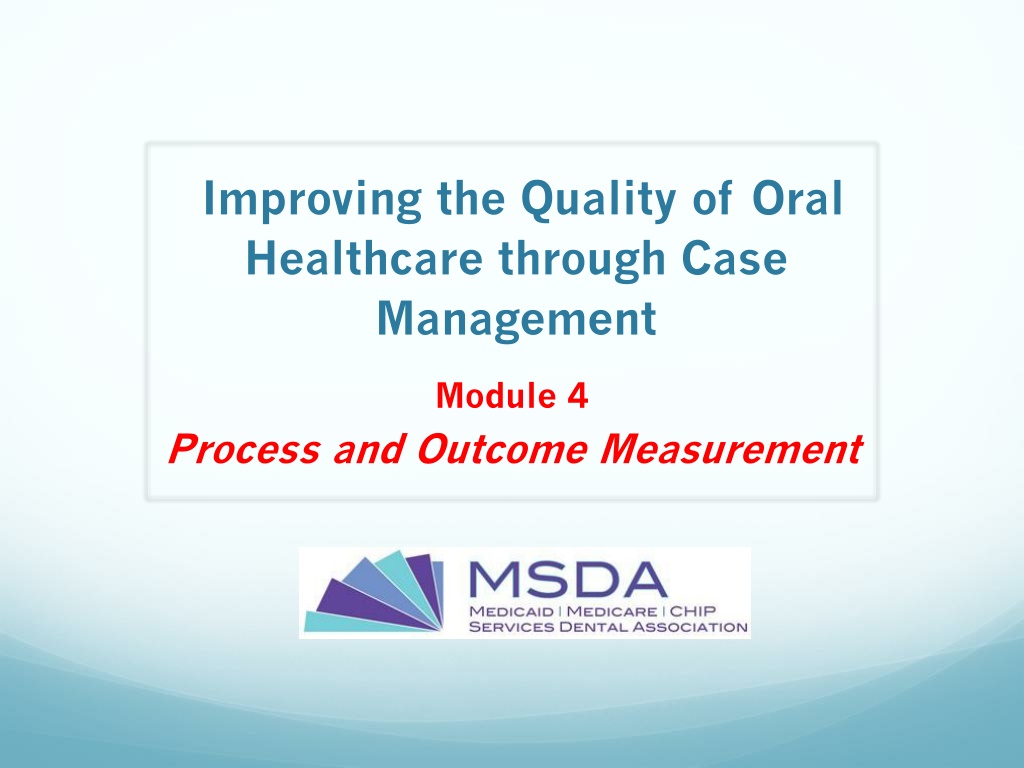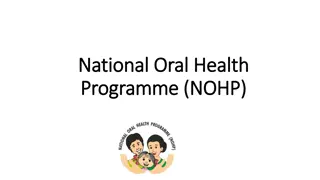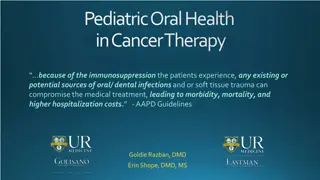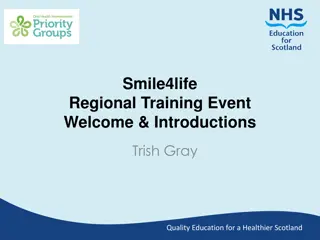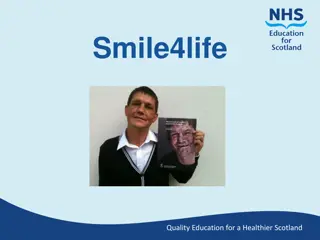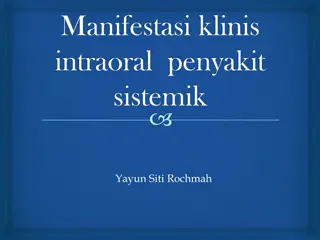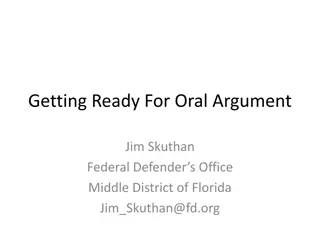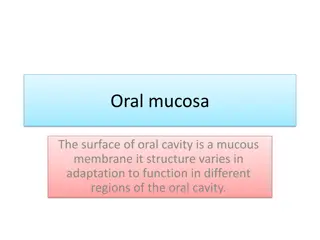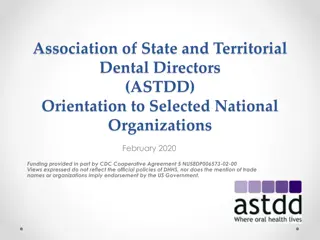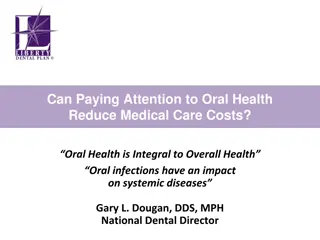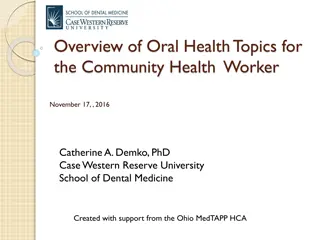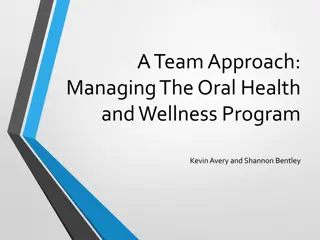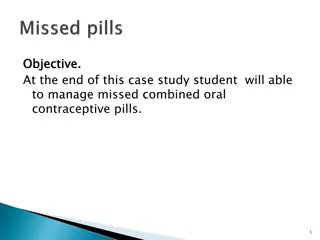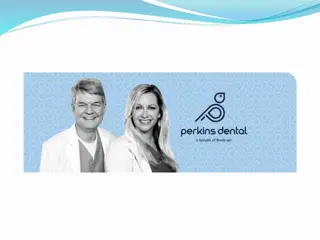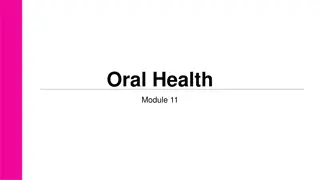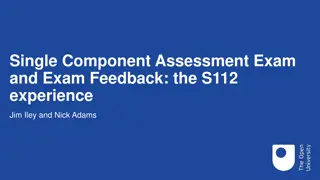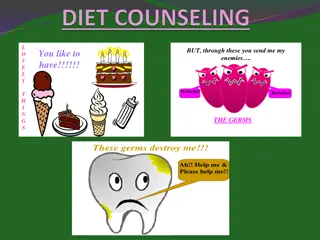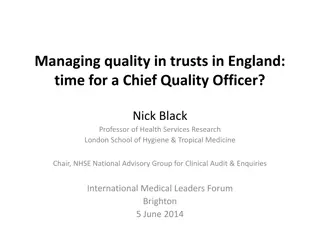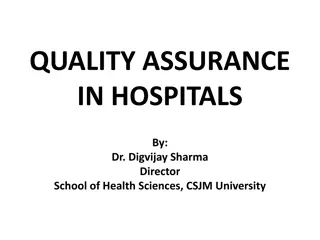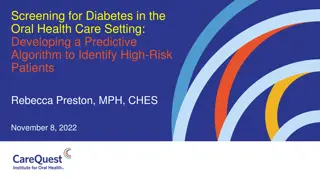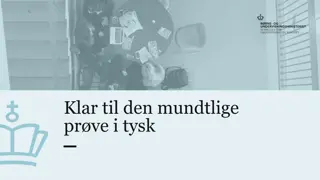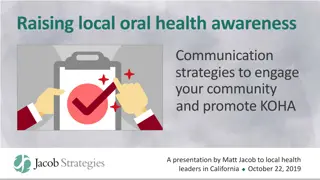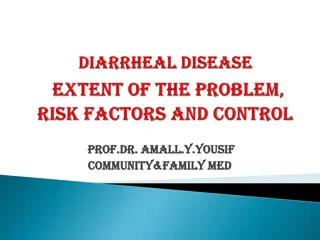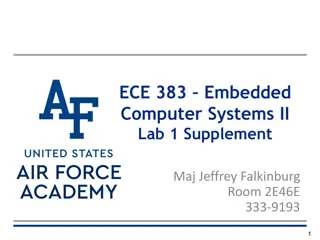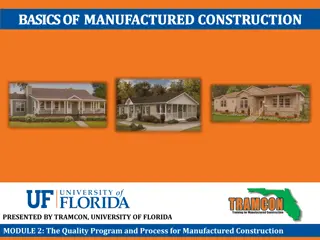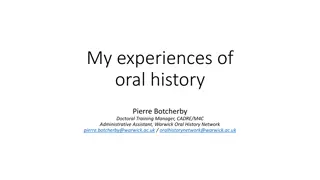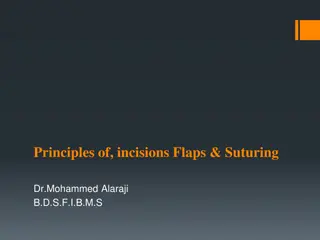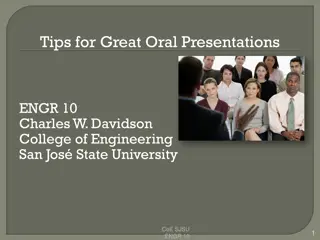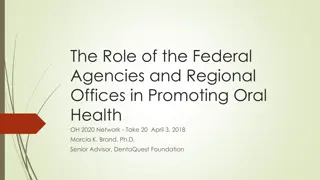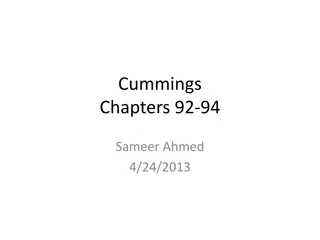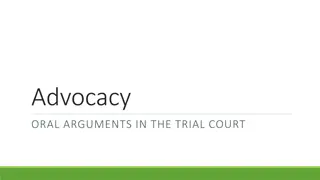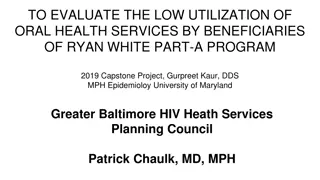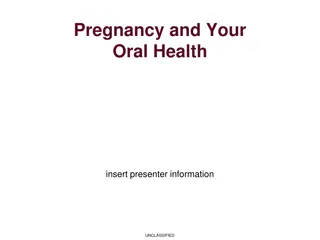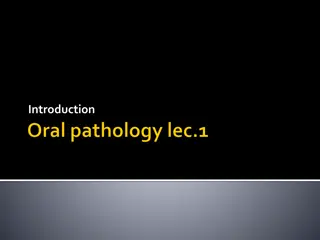Enhancing Oral Healthcare Quality Through Case Management Module 4
This professional education program focuses on advancing the knowledge and skills of dental personnel through training modules aimed at improving the quality of oral healthcare services, enhancing oral health outcomes, and reducing costs. Module 4 specifically covers strategies for Medicaid dental practice management, quality improvement versus quality assurance, measurement techniques, and dashboard development. Expert faculty members contribute to the comprehensive learning experience. Participants can earn CEUs and RI EOHHS certification upon successful completion of all modules and post-tests.
Download Presentation

Please find below an Image/Link to download the presentation.
The content on the website is provided AS IS for your information and personal use only. It may not be sold, licensed, or shared on other websites without obtaining consent from the author. Download presentation by click this link. If you encounter any issues during the download, it is possible that the publisher has removed the file from their server.
E N D
Presentation Transcript
Improving the Quality of Oral Healthcare through Case Management Module 4 Process and Outcome Measurement
Acknowledgements Improving the Quality of Oral Healthcare through Case Management is a professional education and training program designed to advance the knowledge, skill, and competency of the dental workforce. The curricula is made up of 6 training modules which have been made available through the generous support of the following organizations and agencies: Rhode Island Department of Health Rhode Island Executive Office of Health and Human Services Rhode Island Dental Association Medicaid|Medicare|CHIP Services Dental Association Health Resources and Services Administration
Goals of the Course To provide professional education and training to dental personnel in an effort to: 1. Improve the quality oral healthcare services; 2. Improve the oral health outcomes of all; 3. To lower the costs of oral healthcare across the healthcare delivery system.
Overview of the Course I. Introduction II. Learning Modules: 1. Principles of Quality Improvement 2. Principles of Medicaid Dental Practice Management-Part 1 3. Goal Setting 4. Process and Outcome Measurement 5. Principles of Medicaid Dental Practice Management- Part 2 6. Principles of Case Management 7. Module Post-tests III. 1.5 Continuing Education Units (CEU) will be granted upon completion of each module and submission of the respective post-test. IV. RI EOHHS Certification will be granted upon completion of all modules and post-tests and submission of all post-tests.
Advisory Team and Faculty Laurie Leonard, MS Robert Bartro, DDS Beth Marootian Paul Calitri, DMD Timothy Martinez, DMD Marty Dellapenna, RDH, MEd Lynn Douglas Mouden, DDS, MPH Jeff Dodge, DMD Joan Pillsbury Mary Foley, RDH, MPH Renee Rulin, MD Deborah Fuller, DMD John Verbeyst, DMD Mary Ann Heran, RDH, BS Marie Jones-Bridges, RDH, BS
Module 4 Learning Objectives Difference between QI and QA QI Strategies for Medicaid Dental Practice Management Assessing Strategies through Measurement [Plan-Do- Study-Act] Measuring QI-Using data Data collection Dashboard development and routine data analysis
Reviewing Weekly Data Data Dashboards 8
Goal 1-Access Office Data Dashboard 9
Goal 1- Access Team B 160 140 120 # Patients scheduled for week (Private + Medicaid) 100 # Patients seen for week (Private + Medicaid) 80 # RI Medicaid adult patients scheduled for week 60 # RI Medicaid adult patients seen (during week) 40 20 0 1 2 3 4 5 6 7 8 9 10 11 12 10
Goal 2-Productivity Team A 160 140 120 Total # encounters of ALL patients for week 100 80 # RI Medicaid adult patient encounters 60 40 20 0 1 2 3 4 5 6 7 8 9 10 11 12 Weeks 11
Goal 2-Productivity Team B No Show Rate 35 30 Total # no-shows in practice (public + private) 25 20 # RI Medicaid adult patient no-shows 15 10 5 0 1 2 3 4 5 6 7 8 9 10 11 12 12
Goal 3-Financial Team A $18,000 $16,000 $14,000 $12,000 Total gross charges of all procedures for week $10,000 $8,000 $6,000 Total gross charges on all RI Medicaid adult procedures $4,000 $2,000 $0 1 2 3 4 5 6 7 8 9 10 11 12 13 Weeks 13
Goal 4 Quality and Treatment Team B 25 20 Diagnostic 15 Preventive Restorative 10 Emergency 5 0 1 2 3 4 5 6 7 8 9 10 11 12 13 14
Assess Billing & Collection Processes Accounts receivable past 90 days broken out by payer type, i.e. Medicaid, commercial, and self pay Marker for how well the billing process is working Marker for whether the dental staff are consistently collecting co- pays If A/R is high in any payer type, assess entire billing process to determine sources(s) of problems determination eligibility process registration issues provider issues submission of claims management of denials
Review Aging Report If A/R is high for self-pay/SFS patients, review systems and processes Review/create policy defining all aspects of payment Train staff Alert front desk staff that A/R past 90 days from self-pay/SFS patients is a measure used to evaluate their performance Educate patients about why payment is required at the time of the visit Develop scripting for staff to use in communicating with patients Set ceiling targets for A/R Monitor A/R regularly Provide feedback to staff Manage performance failures
Assess Average Reimbursement by Payer Type Type Average Reimbursement by Payer 13,018 total visits 13,018 total visits 30% Medicaid = 3,905 Visits Total Net Revenue for Medicaid = $700,000 Divide $700,000 / 3,905 visits= $179.25 per visit 30% Medicaid= 3,905 Visits Total Net Revenue for Medicaid= $700,000 Divide $700,000/3,905 visits- $179.25 per visit
Monitor Payer Mix Example Medicaid 70% 9,157 Self-pay/Sliding Fee 20% 2,603 Commercial insurance 8% 1,041 Unreimbursed Care 2% 260
Assess Payer Mix and Reimbursement Example Medicaid Self-pay/Sliding Fee Commercial insurance Total Annual Expenses Total Projected Revenue $130 $50 9157 2603 $1,190,410 $130,150 $160 1,041 $156,150 $1,764,500 $1,476,710 + $300,000= $1,776,710
Study Impact of Payer Mix on Sustainability Impact of Payer Mix on Sustainability Now (7,500 visits) 35% Medicaid (avg. revenue/visit = $100) 55% Self-Pay/SFS (avg. revenue/visit = $30) 10% Commercial (avg. revenue/visit = $125) 2,625 visits x $100 = $262,500 4,125 visits x $30 = $123,750 750 visits x $120 = $90,000 Total revenue = $476,250 Total expenses = $500,000 Operating loss = ($23,750) Better (7,500 visits) 50% Medicaid (avg. revenue/visit = $100) 40% Self-Pay/SFS (avg. revenue/visit = $30) 10% Commercial (avg. revenue/visit = $125) 3,750 visits x 100 = $375,000 3,000 visits x $30 = $90,000 750 visits x $120 = $90,000 Total revenue = $555,000 Total expenses = $500,000 Operating surplus = $55,000
Payer Mix, Projected Visits, Actual Visits and Actual Revenue Example Fiscal Year 2015 Projection Too Projected Visits Actual Visits Difference Financial Projections 7084 * See the wor -7084 Patient/Insurance mix: Yearly visits Percent Medicaid 60% 4,250 Percent Self Pay 30% 2,125 Percent Commercial Insurance 5% 354 Percent Other 5% 354 Total 100% 7,084 Reimbursement Rate (per visit): Yearly Revenue Medicaid $ 125.00 531,300.00 $ Self Pay $ 50.00 106,260.00 $ Commercial Insurance $ 160.00 56,672.00 $ Other $ - $ - Total Projected Revenue 694,232.00 $ 61
Exercise #5: Determine Your Payer Mix
STOP RECORDING: Payer Mix and Collections Determine Your Payer Mix and Collections Payer Mix and Collections Quarter 1 # of Visits % Gross Charges Revenue Collected Collection Rate Medicaid #DIV/0! #DIV/0! Self Pay #DIV/0! #DIV/0! Sliding Fee #DIV/0! #DIV/0! Commercial Ins. #DIV/0! #DIV/0! Managed Care #DIV/0! #DIV/0! Totals 0 $ - $ - #DIV/0!
Are you over, under, or just right? Use benchmarks and clinic data to determine weekly & potential visits Total weekly dental provider hour ___ X 1.7=___ Total weekly hygienist provider hours x ___1.2=__ Total other provider hours ___ X 2.0= ___ Add up each providers potential visits ___ Total weekly visits ___ x 46 weeks=___ Yearly Visits Compare! Tips: Expanded function dental assistants multiply dental provider hours by 2.0 Dental students multiply by 1.0 Low on dental assistants or support staff change to 1.5 for dentists
Manage Success Keep it simple! Use good data to measure performance Set realistic and achievable goals Put the goals in a plan with action steps, timelines, roles, and responsibilities Create a culture that embraces change Gain buy-in, include everyone and gather feed back Set accountability Share results!
Key Practice Data and Reports Profit and Loss Statement Gross Charges Net Revenue Total Expenses Transaction or Productivity by Procedure Report Procedures by ADA code- scope of service # of sealants (D1351) #of completed treatments (Dummy Code) New patients (D0150) ER rate (D0140 or dummy code) Aging Report Total outstanding money owed to practice by payer type past 90 days
Key Practice Data and Reports (Continued) Additional Reports (vary on PMS) No-Show rate Emergency rate Unduplicated patients New Patients Number of visits Number of FTE Providers Payer Patient Mix
Key Takeaways Capacity is based on staffing, # of operatories, and clinic hours Capacity should determine the productivity goals Not achieving maximum capacity reduces productivity and negatively impacts your dental program Program goals (both financial & productivity) should be determined using key data reports Program performance should be monitored regularly using a pro forma
Process and Outcome Measurement Take Module 4 Post-Test Now
Faculty Marty Dellapenna, RDH, MEd Ms. Martha Dellapenna is the MSDA Center Director. In this role, Ms. Dellapenna provides oversight to the projects and activities of each the five divisions within the Center. She is the former Project Manager for the Rhode Island Oral Health Access Project. Ms. Dellapenna joined the RI Department of Human Services in the Center for Child and Family Health in 2003 through its project management contractor, Xerox. Ms. Dellapenna s primary role at that time was to manage the development of RIte Smiles, the state s first managed care dental program for young children. Ms. Dellapenna is also the current Chair of the Center for Medicare and Medicaid Services (CMS) Oral Health Technical Advisory Group.
Faculty Mary E. Foley, RDH, MPH Ms. Mary E. Foley is the Executive Director of the Medicaid|Medicare|CHIP Services Dental Association (MSDA). Ms. Foley is a dental hygienist and holds a Masters Degree in Public Health with a concentration in Epidemiology and Biostatistics from the University of Massachusetts School of Public Health and Health Policy. Earlier in her career, she served as the Director of the Massachusetts Department of Public Health, Office of Oral Health. In this role she had oversight of state dental public health programs addressing surveillance; access; prevention; and education. Just prior to her current position, Ms. Foley served as the Dean of the Forsyth School of Dental Hygiene at the Massachusetts College of Pharmacy and Health Sciences in Boston, Massachusetts. Since joining the Medicaid|Medicare|CHIP Services Dental Association, Ms. Foley has been instrumental in broadening national stakeholder collaboration, and advancing state program policy and protocols to improve the health, health care and costs for all Medicaid programs and their beneficiaries.
Faculty Timothy S. Martinez, D.M.D. Timothy S. Martinez, DMD, is the Associate Dean of Community Partnerships and Access to Care at the UNE College of Dental Medicine. Dr. Martinez recently relocated to the New England area after spending six and a half years developing the community-based dental programs for Western University of Health Sciences College of Dental Medicine in Pomona, California. He served as program evaluator at the Forsyth Institute from 2010 to 2011; state dental Medicaid director at the Commonwealth of Massachusetts, Executive Office of Health and Human Services from 2006 to 2009; and dental consultant at the Office of Public Protection, Board of Registration in Dentistry, Massachusetts Department of Public Health from 2005 to 2009. Dr. Martinez also served as dental director for Harbor Health Services Inc. from 1999 to 2003 and dental director at Boston Healthcare for the Homeless from 1994 to 2003. He earned a Doctor of Dental Medicine degree from the Harvard School of Dental Medicine.
